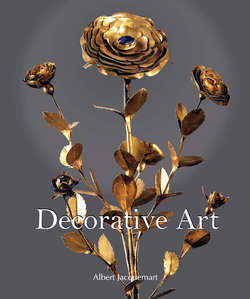Читать книгу Decorative Art - Albert Jacquemart - Страница 5
На сайте Литреса книга снята с продажи.
Furniture
Furniture inlaid with piqué
ОглавлениеWhat the Italians call tarsia, inlay work, would be, if we accept Tommaso Garzoni’s definition in his Piazza Universale, the same thing as the work designated by Pliny, under the name of cerostrotum. According to this etymology, therefore, this word indicates a combination of wood with inlaid pieces of horn and more especially designates the species which is called piqué when it comes from the East and certosino when it is of Italian origin. The intarsiatori, or inlay workers, made their appearance in Italy in the 13th century. It is without a doubt that this work was completed by numerous brethren trained in religious communities; this style is known as, lavoro alia certosa (Carthusian work), or by abbreviation, certosino.
In their eagerness to push wood inlay work beyond its rational limits, artists sought to make it representative of scenes and landscapes, as many celebrated churches can testify. It was a senseless attempt which would end in nothing durable which we would ultimately see renewed in France in later centuries.
The real certosino, which we will now discuss, originated in Venice, and was an Oriental imitation. From the 13th century to the end of the 14th, the inlays were made of black and white wood, sometimes accented with ivory; it was not until later that the frequency of stained wood and use of ivory in its natural tint or a stained green began to increase; sometimes small metallic plaques were added to the work. These primitive labours are almost always of small dimensions, consisting of boxes and jewel cases of rather hasty construction. When the inlaid work is applied to furniture, it is at first with a certain reserve. A bahut belonging to Henry Cernuschi is simply decorated with nets around its circumference, and each side has a circle of diamond encrusted bone on brown wood. This chest dates from the 15th century. Later come the cassoni, the cabinets, the folding tables, the seats with backs in the shape of an X, as well as elegantly carved high-backed chairs in which coloured woods are combined with ivory and form geometrical designs of great richness. Often in circular medallions or in the middle of panels a vase appears from which flowering stems of a blossoming bouquet of fireworks appears. Nothing can be more elegant than this style of furniture, the only defect of which is its uniformity. Notwithstanding some small flowers and rare coiled bouquets, what chiefly predominates in the decoration is a repetition of circles, stars, diamonds and other common geometric figures.
Nearly all the furniture in piqué, alia certosa, comes from Italy; but some may be met with, among the most striking, those which have been manufactured in Portugal. They are generally to be recognised by the abundance of copper sconces used as garnish. The cabinets have complicated corners and keyholes which the gilding renders peculiarly bright.
Guidoccio Cozzarelli, Ulysses’ Departure, detail: The Boatmen, 1480–1481. Poplar wood, cut on the first or last board of the trunk, 34 × 121.5 × 2.5 cm. Castle of Écouen, Musée national de la Renaissance.
